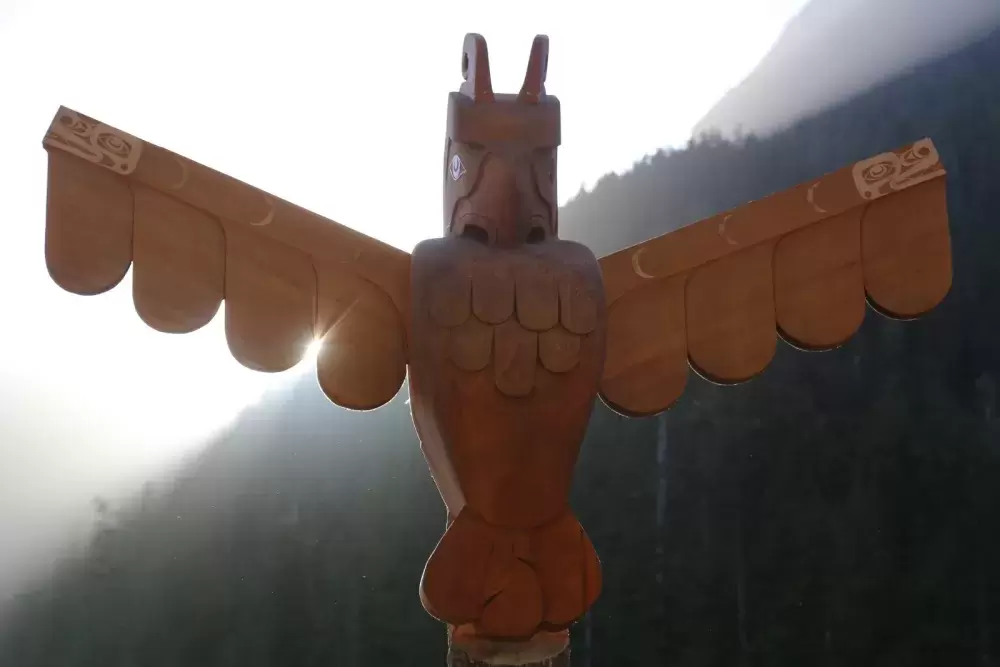“There used to be 200 totem poles lining the front of Opitsaht,” said Tla-o-qui-aht artist Hjalmer Wenstob.
Most were broken or burned when American Captain Robert Gray bombed Opitsaht back in 1792, he added.
Back then, historians say there were 200 long houses in Opitsaht, located on Meares Island across from Tofino. Each longhouse held 50 to 100 people. But the village was abandoned that day, its residents likely at other seasonal villages.
The longhouses and totem poles were hit with cannon balls and burnt, leaving Opitsaht in ruins. But the people rebuilt.
Wenstob said he was talking to his wife about the old village and his wish to see those poles back up.
He was inspired when he saw Nookmis Martin raise a carving completed Joe Martin and other family members in Opitsaht last summer, along with Tla-o-qui-aht artist Joe David's carving which was raised in Tofino in 2018.
“It went up with Carving on the Edge festival,” said Wenstob.
That event served as a catalyst.
“I said to my wife Annika that it’s time to do it now and not wait for funding or projects,” he told Ha-Shilth-Sa. “So, I told Annika that I’d been thinking about putting up a pole a year.”
Annika applied for grants from the First People’s Cultural Council and received funding to work on two poles.
“Ideally, I’d like to see two poles a year going up throughout the territory,” said Wenstob.
He is starting with place markers of importance – “this is to remind people of where they are, and who Tla-o-qui-aht are.”
It was about ten years ago when Wenstob and his brother created the welcome sign that stands on top of Sutton Pass. Now, there is a cedar Thunderbird figure watching over Kennedy River at the Wally Creek lookout located 75 kilometres from Tofino.
The Thunderbird figure was made the same time as a Kakawin (Orca) pole in 2021. The Kakawin figure, also carved by Wenstob, stands on the beach at Esowista. Wenstob calls the first two carvings simple ones.
With the help of his parents and brother Tim, Wenstob created two more figures in 2022. A moon mask was installed at the top of Radar Hill and a carved bentwood box atop a pole was placed at the Ty-Histanis cemetery.
The Thunderbird pole at Kennedy River along the Highway 4 is garnering the most attention. Wenstob says it doesn’t have a plaque, yet, because he wants to consult with Tla-o-qui-aht elders to get the proper place name.
“They (poles) are going to be seen by a lot of tourists, visitors, but we also want some in the community,” said Wenstob.
Annika has successfully applied for another grant and two more carvings are planned for 2023. In addition, Wenstob says another full-sized totem pole will be going up in Ty-Histanis, hopefully this summer.
“We heard most comments from Thunderbird pole on highway by river and it’s been super positive feedback. People are thankful to see our art and acknowledgement of Tla-o-qui-aht when they are in our territory,” said Wenstob. “We want them to know where they are and remind them of Tla-o-qui-aht being present.”
Another benefit the project brings is the joy and pride to the people.
“The community came out to help raise the pole the old-fashioned way, with ropes and beams – it was beautiful to see all the people come together to raise it together,” said Wenstob.
A similar thing happened at the raising of the Thunderbird pole at the river.
“So many people driving by wanted to stop and help raise it. It was beautiful. Art brings people together,” said Wenstob.

